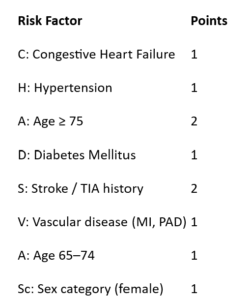“Yeh Dil Maange Rhythm!” — Atrial Fibrillation Explained Bollywood Style
Ever seen a chaotic movie scene where everyone’s running in different directions—no script, no pattern, pure unpredictability? Think of that chawl scene in Welcome where Uday Bhai, Majnu Bhai, and the whole gang are reacting to the same crisis but in completely different ways. That’s exactly what Atrial Fibrillation (AF) looks like on ECG: irregularly irregular, with no P waves, no rhyme, no rhythm!
The Time Bomb Inside the Left Atrium
In AF, the atria quiver instead of contract, leading to blood stasis, especially in the left atrial appendage. This stagnant blood becomes a perfect breeding ground for clots—silent assassins just waiting to break off and cause a stroke. Imagine it as a ticking time bomb, quietly waiting to explode in the form of a massive embolic stroke.
| CHADS2-VASc Score: Stroke Risk Calculator |
| To predict the need for OAC in Atrial fibrillation |
 |
| Score ≥2 (in men) or ≥3 (in women) → Oral anticoagulation is needed (e.g., DOACs or warfarin). For Rheumatic heart disease answer as Warfarin. |
Treatment Strategy (Must know for NEET PG And INICET)
| Recent-Onset AF (<48 hrs) | Long-standing AF (>48 hrs) | |
| Goal | Rhythm control | Rate control ± anticoagulation |
| Option 1: Cardioversion | Unstable: Safe without anticoagulation (if <48 hrs) | Requires 3 weeks of anticoagulation or TEE prior to rule out clots |
| Option 2: Medications | Stable: IV amiodarone, beta-blockers, or CCBs | Beta-blockers like esmolol If Acute pulmonary oedema present: Digoxin If asthma coexists: CCB |
| Anticoagulation? | Based on CHADS2-VASc, especially post-cardioversion | Lifelong if high CHADS2-VASc score |
Why Adenosine Doesn’t Work in Atrial Fibrillation
Adenosine is the magic bullet for AV nodal re-entrant tachycardia (AVNRT) because it blocks the AV node. But in AF, the problem is above the AV node—in the atria themselves. Adenosine may transiently slow the ventricular rate, but it won’t stop the atrial chaos. It’s like trying to calm a riot by switching off the traffic lights—wrong level of control!
Final Take
Atrial Fibrillation isn’t just an arrhythmia—it’s a multifaceted beast. It may start with palpitations, but it can end with paralysis. Early recognition, smart anticoagulation, and proper rate/rhythm strategy can make all the difference. So next time your patient says, “Dhadkan ajeeb chal rahi hai,” think of Majnu Bhai’s gallery—pure chaos—and act before the time bomb goes off.
